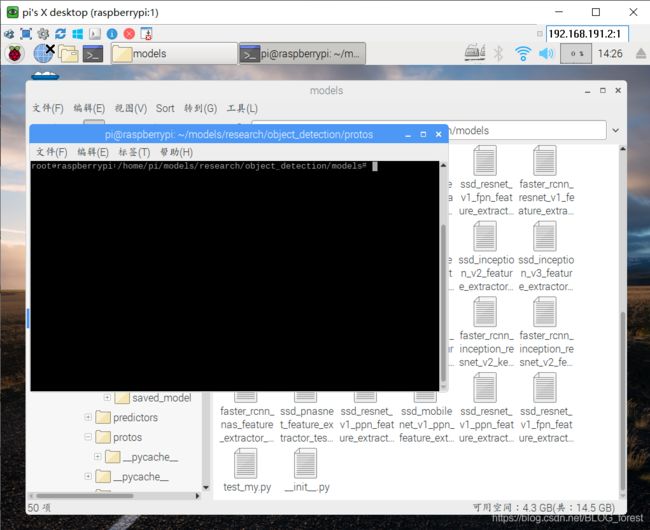树梅派上搭建tensorflow+opencv+pi camera的物体识别
树梅派上搭建tensorflow+opencv的物体识别
- 前言
- 硬件及软件版本
- 安装及环境配置
- 模型配置
- 连接摄像头
- 树莓派显示
- 识别截图
前言
此教程参考自https://www.jianshu.com/p/ea5abe01aaf1 略有改动。
硬件及软件版本
- 树梅派3b+
- 树梅派系统:2018-04-18-raspbian-stretch(自带python 3.5 和 2.7)
- 此处使用3.5版本
- tensorflow 1.13.1
- cv2 3.3.0
- pi camera
- libprotoc 3.8.0
安装及环境配置
可以安装docker通过pull别人打包好的镜像使用docker容器来运行
以下为自行配置:
-安装 opencv-python包
sudo pip3 install opencv-python
此处注意安装之后,检查安装
python3
>>> import cv2
如果出现报错:ImportError: libjasper.so.1: cannot open shared object file: No such file or directory
那么请添加依赖包,详情:import cv2出错
- 安装 matplotlib包
sudo pip3 install matplotlib
- 安装 protobuf
请参考简书的:安装protobuf
此安装过程时间有点长,请耐心等待
- 安装 tensorflow
下载:
tensorflow下载
选择tensorflow-1.13.1-cp35-none-linux_armv7l.whl版本
wget https://github.com/lhelontra/tensorflow-on-arm/releases/download/v1.13.1/tensorflow-1.13.1-cp35-none-linux_armv7l.whl
执行:
sudo pip3 install tensorflow-1.13.1-cp35-none-linux_armv7l.whl
模型配置
-
下载tensorflow model API
model API下载:model API -
下载COCO数据集训练好的判别模型
下载训练好的模型并放到上一步models下的object_detection/models目录
模型下载地址
模型下载:
wget download.tensorflow.org/models/object_detection/ssd_mobilenet_v1_coco_2018_01_28.tar.gz
解压出文件夹ssd_mobilenet_v1_coco_2018_01_28
tar -xzvf ssd_mobilenet_v1_coco_2018_01_28.tar.gz
- proto数据转为python文件
进入目录models/research,运行:
protoc object_detection/protos/*.proto --python_out=.
连接摄像头
- 将pi camera 插入开发板上(注意摄像头并不支持热插拔)
- 开启vnc,激活摄像头功能,运行:
sudo raspi-config
树莓派显示
- hdmi 或者 3.5寸小屏幕都可以
- 远程桌面连接(不推荐)
- vnc连接:
windows下载ultraVNC viewer
在树莓派上安装Tight VNC 包
树莓派中执行:sudo apt-get install tightvncserver
使用ultraVNC viewer连接vncserver :1

显示器连接成功后,执行:
import numpy as np
import os
import sys
import tarfile
import tensorflow as tf
import cv2
import time
from collections import defaultdict
sys.path.append("../..")
from object_detection.utils import label_map_util
from object_detection.utils import visualization_utils as vis_util
MODEL_NAME = 'ssd_mobilenet_v1_coco_2018_01_28'
PATH_TO_CKPT = MODEL_NAME + '/frozen_inference_graph.pb'
PATH_TO_LABELS = os.path.join('/home/pi/models/research/object_detection/data', 'mscoco_label_map.pbtxt')
model_path = "/home/pi/models/research/object_detection/models/ssd_mobilenet_v1_coco_2018_01_28/model.ckpt"
start = time.clock()
NUM_CLASSES = 90
end= time.clock()
print('load the model' ,(end -start))
detection_graph = tf.Graph()
with detection_graph.as_default():
od_graph_def = tf.GraphDef()
with tf.gfile.GFile(PATH_TO_CKPT, 'rb') as fid:
serialized_graph = fid.read()
od_graph_def.ParseFromString(serialized_graph)
tf.import_graph_def(od_graph_def, name='')
label_map = label_map_util.load_labelmap(PATH_TO_LABELS)
categories = label_map_util.convert_label_map_to_categories(label_map, max_num_classes=NUM_CLASSES, use_display_name=True)
category_index = label_map_util.create_category_index(categories)
cap = cv2.VideoCapture(0)
with detection_graph.as_default():
with tf.Session(graph=detection_graph) as sess:
writer = tf.summary.FileWriter("logs/", sess.graph)
sess.run(tf.global_variables_initializer())
loader = tf.train.import_meta_graph(model_path + '.meta')
loader.restore(sess, model_path)
while(1):
start = time.clock()
ret, frame = cap.read()
if cv2.waitKey(1) & 0xFF == ord('q'):
break
image_np =frame
image_np_expanded = np.expand_dims(image_np, axis=0)
image_tensor = detection_graph.get_tensor_by_name('image_tensor:0')
boxes = detection_graph.get_tensor_by_name('detection_boxes:0')
scores = detection_graph.get_tensor_by_name('detection_scores:0')
classes = detection_graph.get_tensor_by_name('detection_classes:0')
num_detections = detection_graph.get_tensor_by_name('num_detections:0')
(boxes, scores, classes, num_detections) = sess.run(
[boxes, scores, classes, num_detections],
feed_dict={image_tensor: image_np_expanded})
vis_util.visualize_boxes_and_labels_on_image_array(
image_np, np.squeeze(boxes),
np.squeeze(classes).astype(np.int32),
np.squeeze(scores),
category_index,
use_normalized_coordinates=True,
line_thickness=6)
end = time.clock()
print ('One frame detect take time:' ,end - start)
cv2.imshow("capture", image_np)
print('after cv2 show')
cv2.waitKey(1)
cap.release()
cv2.destroyAllWindows()
将代码保存为test_my.py保存在models/research/object_detection/models目录下
进入目录models/research/object_detection/models,运行:
sudo chmod 666 /dev/video0
python3 test_my.py



